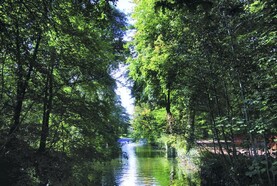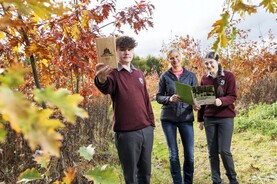Although forest owners and foresters generally take a justified conservative approach to tree species selection, there has been a considerable shift in the afforestation species menu over the past half century. For example, lodgepole pine which formed 21% of annual afforestation programmes in the early 1970s, is no longer planted.
The demise of lodgepole pine coincided with the availability of good-quality land and the shift away from planting low-nutrient peats, while the absence of elm since the 1970s, ash and larch species (hybrid, European and Japanese) during the past two decades is due to their vulnerability to disease.
While European larch is once again considered for afforestation, hybrid and Japanese larch, like ash are unlikely to be approved in the foreseeable future unless – in the case of ash – research into developing dieback-tolerant genotypes is conclusive.
Foresters look to alternative species and this is happening not just in Ireland, but throughout Europe. German foresters are looking at the feasibility of non-native tree species, as Norway spruce, in particular, appears increasingly vulnerable to damage by insect pests, drought and windblow, which are all climate related.
Conifers
Just as Norway spruce is the most important commercial conifer in parts of central Europe and all northern Europe, Sitka spruce is Ireland’s most dominant conifer. Unlike Norway spruce in Europe, Sitka spruce in Ireland – so far – has escaped damage by both bark beetles, while drought and fire are not major issues.
However, the threat of insect pest and fungal diseases remains, so alternative, diverse, commercial coniferous species need to be seriously considered. Coniferous options include the native Scots pine, Douglas fir and Norway spruce, but so far, these do not feature to any extent in Ireland’s afforestation programme.
Only 63ha of Scots pine were planted in 2022 compared with 189ha in 2010 (Table 1), which is a similar percentage of the planting programme, allowing for an overall drop in annual afforestation, which is surprising, as Scots pine qualifies for the native woodland scheme.
Norway spruce has fallen from 539ha to 69ha. This species now forms 3% of a reduced programme, compared with 6.5% in 2010. Douglas fir is not planted and this is likely to remain while Sika deer damage continues unchecked.
When comparing the 2022 planting programme to 2010, it is difficult to fully assess trends, as the total planting programme has fallen by a quarter. Nevertheless, it can be assumed that larch species are being replaced by either Sitka spruce or native broadleaf species, in a declining afforestation programme.
Broadleaves
So what broadleaves are replacing diseased ash? In 2010, it was assumed that alder would be a major alternative species. Based on 2010 data (Table 1), 667ha of alder were planted and it averaged 543ha over the following four years. But since 2015 it has been in freefall and has averaged 86ha over the past four years. In 2022, it made a modest comeback, but now only forms 3.8% of the afforestation programme.
Non-native but naturalised broadleaves have also declined, as the emphasis is on native species. This is a pity, as non-natives such as sweet chestnut, maple, beech are excellent options, but rarely feature in planting programmes, while sycamore could be an ideal replacement for ash.
The species replacing ash in particular, and now alder, are birch and oak, and that category referred to as “other broadleaves” in the Department’s Forests Statistics Ireland 2024.
Birch, which didn’t register in the afforestation data for 2010, has been planted consistently since 2015, as improved birch became available. In 2015, 293ha were planted and while it dipped for a few years, 184ha were planted in 2022 and 195ha last year, which amounted to 12% of a 1,651ha afforestation programme. It looks like improved birch is likely to be the main alternative species to bridge the gap left by ash, although oak is also holding its own. In 2022, 300ha of oak were planted, which represents 13.2% of the total afforestation programme. This is an increase in percentage terms over 2010, when it amounted to 8.4% of a much higher afforestation programme.
Diversity
While Sitka spruce is likely to remain the main species in Irish forestry, there needs to be greater diversity in conifers now rather than being forced to diversify in the future, as some continental foresters are currently experiencing. There is a need to accommodate Norway spruce, Douglas fir, European larch and Scots pine, which ticks a lot of commercial and environment boxes, and qualifies under the Native Forest type.
There is a need to address the option of non-native naturalised European species, especially sycamore, sweet chestnut, beech, maple and possibly some non-European species, such as red oak and southern beech. Future Department statistical publications need to identify individual species that are currently categorised as “additional broadleaves”. This group, which now represents 15.4% of the afforestation programme, compared with 6.8% in 2010, is far too large without itemising the species.
July dashboard data
In July, 36 afforestation licences were issued for a total of 306ha, representing an average annual plantation size of 8.5ha. This brings the total licences to 2,423ha for the first seven months, which is roughly the same as 2022. With 70% take up, it remains to be seen if afforestation will surpass the 2022 total of 2,423ha. What may help, according to a Department spokesperson, are the additional 173 applications (1,394 ha) already approved under Forestry Programme 2014-2020 “that hadn’t commenced planting and have now opted into the new Forestry Programme 2023-2027”. Felling licences issued for July amounted to 1,624ha, which are estimated to produce 541,000m3.
Total area licenced to date is 12,964ha, which should produce 3,721m3 over the next 10 years. If this trend is continued, 25,000ha of felling licences will be issued by year end, which is well down on 2023 (33,416ha) and 2022 (46,027ha). A worrying trend is the low rates of thinning licence approvals – and presumably applications – compared with clearfells.
Licences were issued for 18km of forest roads, bringing the total to 186km so far, which at year end should be back on track, with 293km of licences approved in 2022.






 This is a subscriber-only article
This is a subscriber-only article










SHARING OPTIONS: